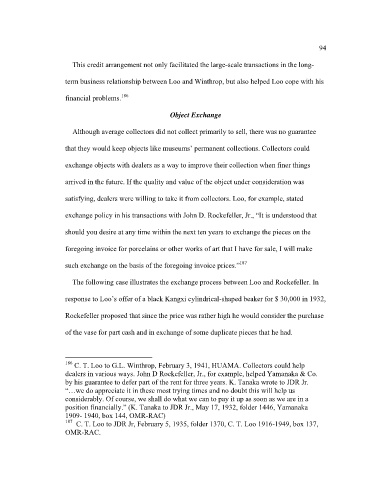Page 94 - C.T. Loo A paper about his impact and activities in the Chinese art Market
P. 94
94
This credit arrangement not only facilitated the large-scale transactions in the long-
term business relationship between Loo and Winthrop, but also helped Loo cope with his
financial problems. 186
Object Exchange
Although average collectors did not collect primarily to sell, there was no guarantee
that they would keep objects like museums’ permanent collections. Collectors could
exchange objects with dealers as a way to improve their collection when finer things
arrived in the future. If the quality and value of the object under consideration was
satisfying, dealers were willing to take it from collectors. Loo, for example, stated
exchange policy in his transactions with John D. Rockefeller, Jr., “It is understood that
should you desire at any time within the next ten years to exchange the pieces on the
foregoing invoice for porcelains or other works of art that I have for sale, I will make
187
such exchange on the basis of the foregoing invoice prices.”
The following case illustrates the exchange process between Loo and Rockefeller. In
response to Loo’s offer of a black Kangxi cylindrical-shaped beaker for $ 30,000 in 1932,
Rockefeller proposed that since the price was rather high he would consider the purchase
of the vase for part cash and in exchange of some duplicate pieces that he had.
186
C. T. Loo to G.L. Winthrop, February 3, 1941, HUAMA. Collectors could help
dealers in various ways. John D Rockefeller, Jr., for example, helped Yamanaka & Co.
by his guarantee to defer part of the rent for three years. K. Tanaka wrote to JDR Jr.
“…we do appreciate it in these most trying times and no doubt this will help us
considerably. Of course, we shall do what we can to pay it up as soon as we are in a
position financially.” (K. Tanaka to JDR Jr., May 17, 1932, folder 1446, Yamanaka
1909- 1940, box 144, OMR-RAC)
187 C. T. Loo to JDR Jr, February 5, 1935, folder 1370, C. T. Loo 1916-1949, box 137,
OMR-RAC.

